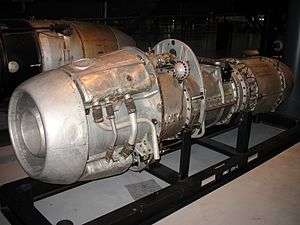Ishikawajima Ne-20
| Ne-20 | |
|---|---|
 | |
| Ishikawajima Ne-20 | |
| Type | Turbojet |
| Manufacturer | Ishikawajima-Harima Heavy Industries |
| First run | 1945 |
| Major applications | Nakajima Kikka |
| Number built | c.5 |
|
| |
The Ishikawajima Ne-20 (Japanese: 石川島 ネ-20) was Japan's first turbojet engine. It was developed during World War II in parallel with the nation's first military jet, the Nakajima Kikka.
Design and development
The decision to manufacture this engine came about because of the unsuitability of two earlier powerplants selected for the Kikka, the Tsu-11 and the Ne-12. The Ne-20 was made possible by Imperial Japanese Navy engineer Eichi Iwaya obtaining photographs and a single cut-away drawing of the German BMW 003 engine.
Only a small number of these engines, perhaps fifty, were produced before the end of the war. Two of them were used to power the Kikka on its only flight on August 7, 1945. Only a few of the engines under construction survived. It was also planned to use the engine to power a version of the Ohka kamikaze weapon, but this was not implemented before the end of the war.
Variants
- Ne-20
- Standard production engines
- Ne-20-Kai
- Up-rated version
Engines on display
Three Ne-20s have been preserved to the present day, one at Ishikawajima-Harima's internal company museum in Tanashi, and two at the National Air and Space Museum in Washington, DC.
Specifications (Ne-20)
Data from Turbojet History and Development 1930-1960 Volume 2:USSR, USA, Japan, France, Canada, Sweden, Switzerland, Italy and Hungary[1]
General characteristics
- Type: Turbojet engine
- Length: 2700 mm
- Diameter: 620 mm
- Dry weight: 470 kg
Components
- Compressor: 8-stage Axial compressor
- Combustors: Annular combustion chamber
- Turbine: 1-stage axial turbine
Performance
- Maximum thrust: 475 kgf (4.66 kN, 1,047 lbf) at 11,000 rpm
- Specific fuel consumption: 1.5 lb/lb/hr
- Thrust-to-weight ratio: 1.01
See also
- Comparable engines
- Related lists
References
External links
| Wikimedia Commons has media related to Ishikawajima Ne-20. |
Bibliography
- Kay, Anthony L. (2007). Turbojet History and Development 1930-1960 Volume 2:USSR, USA, Japan, France, Canada, Sweden, Switzerland, Italy and Hungary (1st ed.). Ramsbury: The Crowood Press. ISBN 978-1861269393.